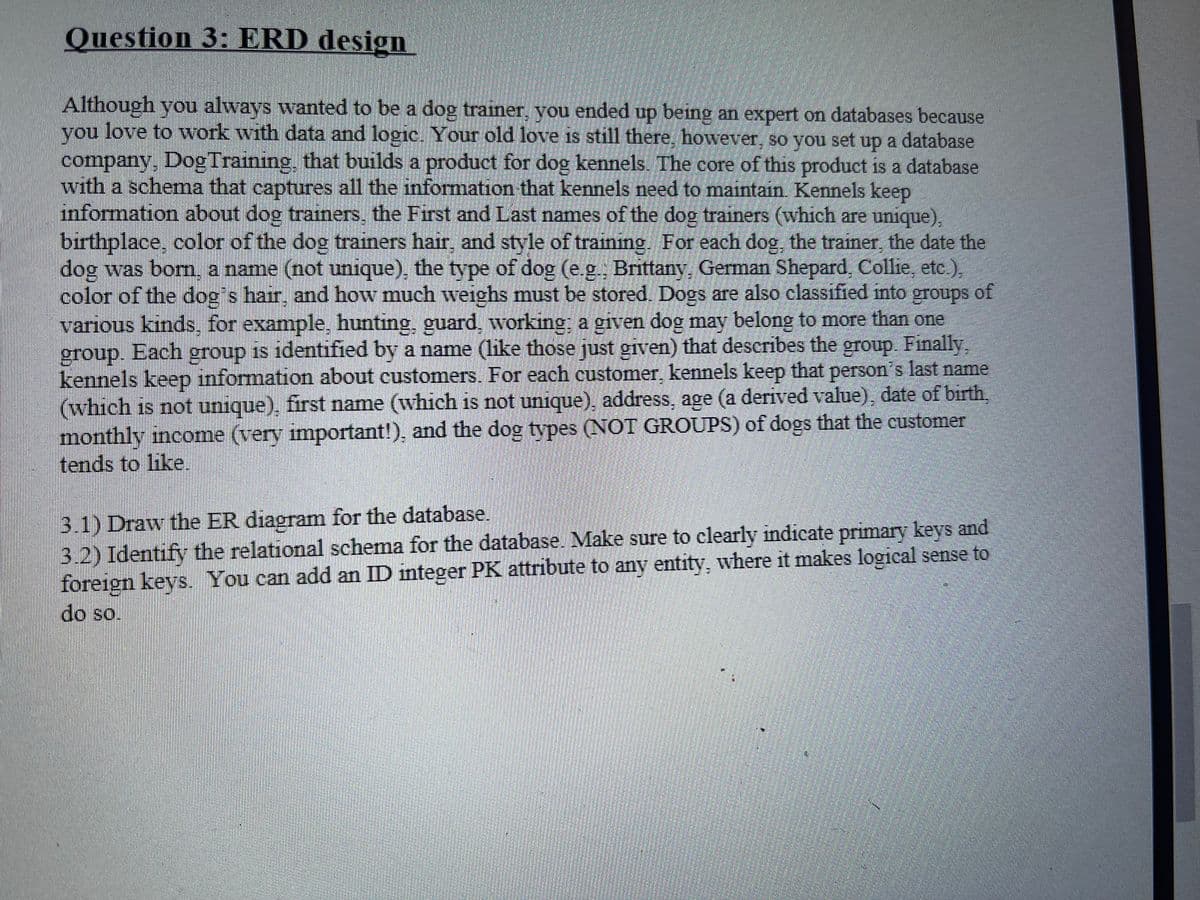Question 3: ERD design Although you always wanted to be a dog trainer, you ended up being an expert on databases because you love to work with data and logic. Your old love is still there, however, so you set up a database company, DogTraining, that builds a product for dog kennels. The core of this product is a database with a schema that captures all the information that kennels need to maintain. Kennels keep information about dog trainers, the First and Last names of the dog trainers (which are unique), birthplace, color of the dog trainers hair, and style of training. For each dog, the trainer, the date the dog was born, a name (not unique), the type of dog (e.g., Brittany, German Shepard, Collie, etc.), color of the dog's hair, and how much weighs must be stored. Dogs are also classified into groups of various kinds, for example, hunting, guard, working; a given dog may belong to more than one group. Each kennels keep information about customers. For each customer, kennels keep that person's last name (which is not unique), first name (which is not unique), address, age (a derived value), date of birth, monthly income (very important!), and the dog types (NOT GROUPS) of dogs that the customer tends to like. group is identified by a name (like those just given) that describes the group. Finally, 3.1) Draw the ER diagram for the database. 3.2) Identify the relational schema for the database. Make sure to clearly indicate primary keys and foreign keys. You can add an ID integer PK attribute to any entity, where it makes logical sense to do so.
Question 3: ERD design Although you always wanted to be a dog trainer, you ended up being an expert on databases because you love to work with data and logic. Your old love is still there, however, so you set up a database company, DogTraining, that builds a product for dog kennels. The core of this product is a database with a schema that captures all the information that kennels need to maintain. Kennels keep information about dog trainers, the First and Last names of the dog trainers (which are unique), birthplace, color of the dog trainers hair, and style of training. For each dog, the trainer, the date the dog was born, a name (not unique), the type of dog (e.g., Brittany, German Shepard, Collie, etc.), color of the dog's hair, and how much weighs must be stored. Dogs are also classified into groups of various kinds, for example, hunting, guard, working; a given dog may belong to more than one group. Each kennels keep information about customers. For each customer, kennels keep that person's last name (which is not unique), first name (which is not unique), address, age (a derived value), date of birth, monthly income (very important!), and the dog types (NOT GROUPS) of dogs that the customer tends to like. group is identified by a name (like those just given) that describes the group. Finally, 3.1) Draw the ER diagram for the database. 3.2) Identify the relational schema for the database. Make sure to clearly indicate primary keys and foreign keys. You can add an ID integer PK attribute to any entity, where it makes logical sense to do so.
Database Systems: Design, Implementation, & Management
12th Edition
ISBN:9781305627482
Author:Carlos Coronel, Steven Morris
Publisher:Carlos Coronel, Steven Morris
Chapter9: Database Design
Section: Chapter Questions
Problem 7P
Related questions
Question

Transcribed Image Text:Question 3: ERD design
Although you always wanted to be a dog trainer, you ended up being an expert on databases because
love to work with data and logic. Your old love is still there, however, so you set up a database
you
company, Dog Training, that builds a product for dog kennels. The core of this product is a database
with a schema that captures all the infonmation that kennels need to maintain Kennels keep
information about dog trainers, the First and Last names of the dog trainers (which are unique),
birthplace, color of the dog trainers hair, and style of training. For each dog, the trainer, the date the
dog was bom, a name (not unique), the type of dog (e.g. Brittany, German Shepard, Collie, etc.),
color of the dog's hair, and how much weighs must be stored. Dogs are also classified into groups of
various kinds, for example, hunting, guard, working; a given dog may belong to more than one
group. Each group is identified by a name (like those just given) that describes the group. Finally,
kennels keep information about customers. For each customer, kennels keep that person's last name
(which is not unique), first name (which is not unique), address, age (a derived value), date of birth,
monthly income (very important!), and the dog tvpes (NOT GROUPS) of dogs that the customer
tends to like.
3.1) Draw the ER diagram for the database.
3.2) Identify the relational schema for the database. Make sure to clearly indicate primary keys and
foreign kevs. You can add an ID integer PK attribute to any entity, where it makes logical sense to
do so.
Expert Solution
This question has been solved!
Explore an expertly crafted, step-by-step solution for a thorough understanding of key concepts.
This is a popular solution!
Trending now
This is a popular solution!
Step by step
Solved in 2 steps with 1 images

Recommended textbooks for you

Database Systems: Design, Implementation, & Manag…
Computer Science
ISBN:
9781305627482
Author:
Carlos Coronel, Steven Morris
Publisher:
Cengage Learning

Fundamentals of Information Systems
Computer Science
ISBN:
9781337097536
Author:
Ralph Stair, George Reynolds
Publisher:
Cengage Learning

Fundamentals of Information Systems
Computer Science
ISBN:
9781305082168
Author:
Ralph Stair, George Reynolds
Publisher:
Cengage Learning

Database Systems: Design, Implementation, & Manag…
Computer Science
ISBN:
9781305627482
Author:
Carlos Coronel, Steven Morris
Publisher:
Cengage Learning

Fundamentals of Information Systems
Computer Science
ISBN:
9781337097536
Author:
Ralph Stair, George Reynolds
Publisher:
Cengage Learning

Fundamentals of Information Systems
Computer Science
ISBN:
9781305082168
Author:
Ralph Stair, George Reynolds
Publisher:
Cengage Learning